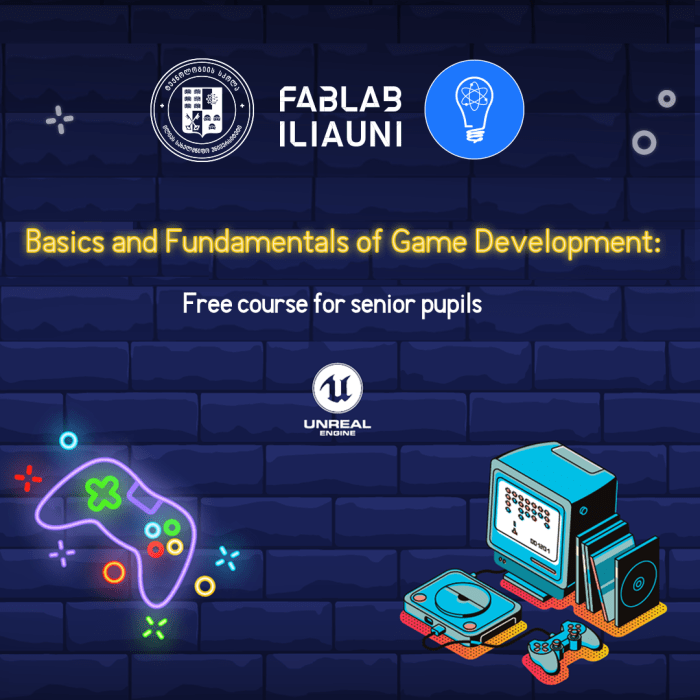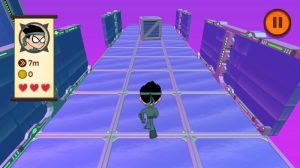
Ever dreamed of crafting your own video game? From pixelated platformers to sprawling RPGs, the world of game development is vast and exciting. This exploration of game development tutorials dives into the best resources, different learning styles, and the ever-evolving landscape of game creation. Whether you’re a coding newbie or a seasoned programmer, we’ll uncover the perfect path to turn your game design dreams into reality!
We’ll explore the top tutorial platforms, comparing video guides to interactive lessons, and examining how tutorials cater to various game genres (think puzzle games versus action-packed adventures) and engines (Unity, Unreal Engine, Godot – oh my!). We’ll also consider the target audience, from kids coding their first game to experienced developers polishing their latest masterpiece. Plus, we’ll tackle the unique challenges and opportunities of online game development, touching upon monetization, legal considerations, and responsible gaming practices.
Popularity and Trends in Game Development Tutorials
The world of game development is booming, and with it, the demand for accessible and effective tutorials. Aspiring game developers are constantly seeking knowledge, and the platforms offering this knowledge are evolving rapidly to meet their needs. This section will explore the current landscape of game development tutorials, highlighting popular platforms, tutorial formats, and recent trends.
Top Game Development Tutorial Platforms
Choosing the right platform for learning game development can significantly impact the learning experience. Three platforms consistently rank highly: YouTube, Udemy, and Unity Learn. YouTube’s vast library of free content caters to diverse learning styles and budgets, while Udemy offers structured courses often with certifications, and Unity Learn provides specialized tutorials tailored to the popular Unity game engine.
- YouTube: Strengths include its vast free content library, diverse creators, and immediate accessibility. Weaknesses include inconsistent quality, a lack of structured learning paths, and difficulty in verifying information accuracy.
- Udemy: Strengths include structured courses, often with instructor interaction and certificates of completion. Weaknesses include a wide range of quality, a reliance on paid courses, and potential for outdated content.
- Unity Learn: Strengths include its focus on the popular Unity engine, high-quality content directly from the source, and a structured learning path. Weaknesses include a limited scope (only Unity), and less diversity in teaching styles compared to broader platforms.
Tutorial Formats and Learning Styles
Game development tutorials are available in various formats, each appealing to different learning styles. Video tutorials, text-based tutorials, and interactive tutorials each have their own advantages and disadvantages. The most effective format depends heavily on individual preferences and learning goals.
- Video Tutorials: These offer visual demonstrations and explanations, making them ideal for visual learners. However, they can be time-consuming and may lack the depth of text-based tutorials.
- Text-Based Tutorials: These provide detailed explanations and code examples, appealing to learners who prefer a more structured and in-depth approach. However, they can be less engaging for visual learners and require a higher level of self-discipline.
- Interactive Tutorials: These allow hands-on practice within the tutorial itself, providing immediate feedback and reinforcing concepts. They are generally more engaging and effective but often require specific software or platforms.
Evolution of Game Development Tutorial Content (Past Five Years)
The past five years have witnessed significant changes in game development tutorial content. The rise of game engines like Unreal Engine 5 and Godot, alongside advancements in technologies like VR/AR development, have driven a shift in tutorial focus. Additionally, the increasing popularity of online learning platforms has led to more structured and professionally produced tutorials.For example, tutorials focusing solely on older game engines like Unity 4 are becoming less prevalent, replaced by tutorials utilizing the latest versions and features.
The integration of more advanced topics, such as AI programming and procedural generation, is also more common. Furthermore, the rise of platforms like Twitch and YouTube Live has introduced live streaming tutorials, allowing for real-time interaction and feedback. This shift reflects a move towards more accessible, interactive, and up-to-date learning experiences.
Types of Games Covered in Tutorials

Game development tutorials span a vast landscape, catering to various skill levels and interests. Choosing the right tutorial depends on your desired genre, preferred engine, and available time commitment. This section breaks down the common types of games featured in tutorials, the engines used to create them, and the associated time and complexity levels.
Game Genres in Tutorials
Tutorials frequently focus on popular and relatively accessible game genres. This allows beginners to grasp core concepts before tackling more complex mechanics. Examples include:
- Platformers: These games involve navigating a 2D or 3D environment, overcoming obstacles, and often collecting items. Tutorials might cover creating a simple jumping mechanic, implementing level design, and adding enemies.
- RPGs (Role-Playing Games): These games often feature character progression, storytelling, and combat. Tutorials may focus on creating character sheets, implementing dialogue systems, and designing basic combat encounters. Simpler RPGs might focus on top-down perspective and turn-based combat to reduce complexity.
- Puzzle Games: These games emphasize problem-solving and logical thinking. Tutorials might teach you how to create puzzles using tile-based systems, implement scoring mechanisms, and design level progression.
- Shooter Games: Tutorials can cover the basics of creating a first-person or third-person shooter, focusing on aspects like weapon mechanics, enemy AI, and player movement.
- Strategy Games: Tutorials might introduce concepts like turn-based combat, resource management, and unit control, often simplified for beginners.
Game Engines Used in Tutorials
Different game engines offer varying levels of ease of use and functionality. The choice often depends on your experience and project goals.
- Unity: A widely used, cross-platform engine known for its beginner-friendly interface and vast community support. Pros include ease of learning, extensive resources, and a large asset store. Cons can include a steeper learning curve for more advanced features and potential performance limitations in complex projects.
- Unreal Engine: A powerful engine known for its high-fidelity graphics and robust features, but it can have a steeper learning curve for beginners. Pros include stunning visuals and advanced tools. Cons include a more complex interface and a greater initial time investment for learning.
- Godot Engine: A free and open-source engine gaining popularity due to its ease of use and efficient workflow. Pros include its beginner-friendliness, open-source nature, and excellent performance. Cons include a smaller community compared to Unity or Unreal Engine, and potentially fewer readily available assets.
Tutorial Complexity and Time Commitment
The time and effort required for a game development tutorial vary significantly depending on the chosen game genre and engine.
| Game Genre | Engine | Estimated Time (Hours) | Difficulty Level |
|---|---|---|---|
| Simple Platformer | Unity | 50-100 | Beginner |
| Basic Puzzle Game | Godot | 30-60 | Beginner |
| Top-Down RPG | Unity | 100-200+ | Intermediate |
| First-Person Shooter (Simplified) | Unreal Engine | 150-300+ | Intermediate/Advanced |
Target Audience of Game Development Tutorials
Game development tutorials cater to a wide spectrum of learners, from absolute beginners with no programming experience to seasoned professionals looking to refine their skills. Understanding the target audience is crucial for crafting effective and engaging learning materials. The assumed skill level and prior experience significantly influence the content, pacing, and complexity of the tutorials.Different tutorials assume varying levels of prior knowledge.
Some are designed for complete novices, introducing fundamental programming concepts alongside game development principles. Others target intermediate users who already possess basic programming skills but lack experience with game engines or specific development frameworks. Advanced tutorials, on the other hand, often delve into optimization techniques, complex algorithms, and specialized tools, presupposing a solid understanding of game architecture and design patterns.
Skill Levels and Prior Experience Assumed by Tutorials
The assumed skill level varies dramatically across different tutorials. Beginner tutorials typically assume no prior programming or game development experience. They start with the absolute basics, such as setting up a development environment and understanding fundamental programming concepts like variables, loops, and conditional statements. Intermediate tutorials build upon this foundation, introducing more advanced concepts like object-oriented programming, design patterns, and working with game engines.
Advanced tutorials are geared towards experienced developers, focusing on optimization techniques, advanced algorithms, and specialized tools. For example, a beginner tutorial might focus on creating a simple 2D game using a visual scripting tool, while an advanced tutorial might cover optimizing a complex 3D game for different platforms.
Differences in Tutorial Content for Beginners versus Experienced Developers
Beginner tutorials prioritize simplicity and clarity. They break down complex concepts into smaller, manageable chunks, using simple language and avoiding jargon. They often incorporate visual aids, such as diagrams and screenshots, to aid understanding. Hands-on exercises and projects are frequently included to reinforce learning. In contrast, advanced tutorials are more concise and assume a deeper understanding of underlying principles.
They may cover complex algorithms, optimization strategies, and advanced features of game engines, often relying on the learner’s existing knowledge and problem-solving abilities. For instance, a beginner tutorial might explain the basics of collision detection using simple examples, while an advanced tutorial might delve into more sophisticated algorithms for efficient collision detection in complex 3D environments.
Hypothetical Tutorial Series for Children Aged 8-12
This series, titled “Game Crafting Adventures,” would focus on visual scripting and simple game mechanics, using a drag-and-drop interface to minimize the need for complex coding.
Content and Structure of “Game Crafting Adventures”
The series would be structured across several modules, each building upon the previous one. Module 1 would introduce the basics of game design principles, such as character creation, level design, and simple game mechanics. Module 2 would introduce the visual scripting environment, teaching children how to create interactive elements and control game objects. Module 3 would focus on creating simple 2D games, such as platformers or puzzle games.
Module 4 would introduce more advanced concepts, such as animation, sound effects, and scoring systems. Each module would include interactive exercises, small projects, and a final project to consolidate learning. The language would be simple and engaging, using age-appropriate analogies and examples. The tutorials would be visually appealing, with colorful graphics and animations to maintain children’s interest.
The final project could involve creating a complete game that the children can share with friends and family. This approach would foster creativity and problem-solving skills while introducing the fundamentals of game development in an accessible and fun way.
Online Game Development and Related Topics

Online game development presents a unique set of challenges and opportunities compared to its offline counterpart. The interconnected nature of online games necessitates considerations of scalability, security, and persistent gameplay that are less critical in offline titles. However, the potential reach and revenue streams of online games are significantly greater, making it an attractive field for developers.
Challenges and Opportunities in Online Game Development
Developing online games requires a different skill set and infrastructure than offline games. Challenges include managing server infrastructure, implementing robust anti-cheat measures, and dealing with potentially massive player bases. Opportunities include accessing a global audience, generating revenue through various monetization models (including microtransactions and subscriptions), and fostering a vibrant community around the game. The ongoing nature of online games also allows for continuous updates and expansion, extending the game’s lifespan significantly.
Examples of Successful Online Games and Factors Contributing to Their Popularity
Games like
- Fortnite*,
- League of Legends*, and
- Fortnite*’s success, for instance, can be attributed to its free-to-play model, its constant evolution with new seasons and items, and its highly accessible gameplay loop.
- World of Warcraft*’s longevity highlights the power of a rich, persistent world and a loyal player base built over years of development and community interaction.
World of Warcraft* exemplify successful online games. Their popularity stems from a combination of factors
engaging gameplay mechanics, compelling narratives (where applicable), regular content updates, strong community engagement, and effective marketing strategies.
Best Practices for Designing Engaging and Accessible Online Games for Girls
Designing engaging online games for girls requires understanding their preferences and interests. This includes incorporating diverse characters and narratives that reflect their experiences, avoiding stereotypical gender roles, and focusing on gameplay mechanics that are intuitive and rewarding. Games that emphasize creativity, collaboration, and social interaction tend to resonate well with this demographic. Examples could include games focusing on fashion design, character customization with extensive options, or cooperative puzzle-solving scenarios.
Free-to-Play versus Paid Online Games: Monetization Strategies
Free-to-play (F2P) games rely on microtransactions, in-app purchases, or advertisements to generate revenue, while paid games typically charge an upfront fee. F2P games need to carefully balance monetization with gameplay to avoid alienating players with aggressive monetization practices. Paid games, on the other hand, must offer significant value and content to justify their price tag. Successful monetization strategies in both models hinge on providing players with choices and avoiding pay-to-win mechanics.
Legal and Ethical Considerations Surrounding Online Gambling and Casino Games
Online gambling presents significant legal and ethical challenges. Regulations vary widely across jurisdictions, with some countries outright banning online gambling while others have established licensing and regulatory frameworks. Ethical concerns center around responsible gaming practices, including measures to prevent addiction and protect vulnerable individuals. Age verification, deposit limits, and self-exclusion options are crucial components of responsible online gambling.
Business Models of Online Casino Affiliates
Online casino affiliates act as intermediaries, driving traffic to online casinos in exchange for commissions on player deposits or revenue generated. Their business models often involve search engine optimization (), content marketing, and paid advertising. Affiliates play a significant role in the online gambling industry by increasing the visibility of online casinos and attracting new players. However, ethical considerations regarding transparency and responsible advertising are paramount.
Mechanics of a Typical Gambling Game: Slot Machine and Poker
Slot machines rely on random number generators (RNGs) to determine the outcome of each spin. The probability of winning is predetermined by the game’s payout table and the number of symbols on the reels. Poker, on the other hand, involves strategic decision-making based on probabilities and opponent behavior. The odds of winning in poker depend on the player’s hand, the community cards, and the actions of other players.
Understanding the underlying probability and statistics is crucial for informed gameplay in both cases.
The house always has an edge.
Resources for Players Seeking Advice on Online Casino Games
Several resources are available for players seeking advice on online casino games. These include:
- Reputable online gambling review sites that provide information on licensed and regulated casinos.
- Organizations dedicated to responsible gambling, offering resources and support for problem gamblers.
- Government websites providing information on gambling regulations and licensing.
Legal Status of Online Gambling in Different Countries
| Country | Legal Status | Regulations | Restrictions |
|---|---|---|---|
| United States | Varied by state | State-specific regulations | Restrictions on certain games and operators |
| United Kingdom | Legal with licensing | Strict regulations by the UK Gambling Commission | Age restrictions, advertising restrictions |
| Canada | Legal in some provinces | Provincial regulations | Restrictions on certain games and operators |
| Australia | Legal with licensing | State and territory regulations | Restrictions on advertising and certain games |
Concluding Remarks
So, are you ready to embark on your game development journey? This deep dive into game development tutorials has shown that the path to creating your own game is more accessible than ever. With the right resources, learning style, and a dash of creativity, you can transform your gaming passion into a tangible, playable experience. Whether you’re aiming for a simple puzzle game or a complex online world, remember that the first step is always the most exciting.
Now go forth and create!
FAQ Corner
What’s the best game engine for beginners?
Godot is often recommended for beginners due to its user-friendly interface and open-source nature. Unity is also popular and has extensive resources, but it might have a steeper learning curve initially.
How much time should I dedicate to learning game development?
It depends on your goals and learning pace. Creating a simple game can take weeks, while more complex projects could take months or even years.
Are there free game development tutorials available?
Yes! Many platforms offer free tutorials, including YouTube channels, online courses (often with free introductory sections), and official engine documentation.
Do I need a computer science degree to make games?
Absolutely not! While a CS background can be helpful, many successful game developers are self-taught. Passion, dedication, and a willingness to learn are far more important.






